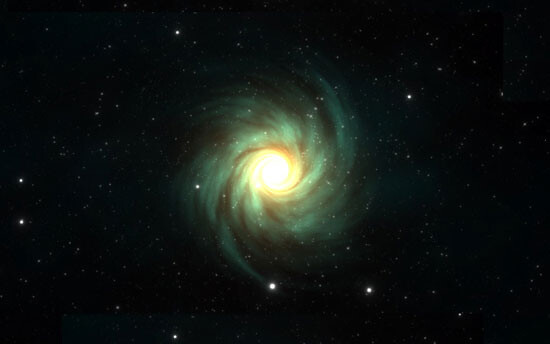Learn the aesthetic error of submitting everything to a law: leveling the local event produces boredom and ugliness, a world without landscapes, books without pages, deserts. Take everything away and you will not see. To see space demands time, do not kill time. Avoid the symmetrical error of being satisfied with fragments.
—Michel Serres1
In Post-Cinematic Affect, Steven Shaviro defines accelerationist aesthetics in two ways. First, he points to the “‘disruption,’ or the radical ‘break,’ without any positive content, which is all that remains for Jameson of the Utopian gesture today.”2 More optimistically, he emphasizes the need to think futurity and speed in new ways when he states that what we have here and now is not enough, and is vulnerable to capitalism’s voracious appetite for assimilation. Through the exhaustion of the now we can play with what’s left, the future-now.3 Time is problematized, collapsed, and enfolded, as it always has been in any discussion of the post-. This article will explore the ways futurity, time, and acceleration can constitute a demand for the next that outruns capital’s consumption of the now. It attends to the critical ethical components of this irreversible time in order to avoid the tendency of accelerationism to become just one more speed politics that furthers capitalism’s replacement compulsion, its techniques for devastating all to come.4
One of the crucial ethical elements Shaviro emphasizes in his discussion of affect is that affect has no lack or opposite—all is affect. The posthuman vocabulary of break, fracture, and rupture is therefore no less affective for its empty contents. Indeed, this is its most insidious quality; as Shaviro puts it, “the prison has no outside.”5 Accelerationism seems to have been misapplied to velocity and capitalist replacement culture, but Shaviro—following Guattari and Deleuze’s use of the concept of time via speed as a qualitative (and mediative) duration—frames acceleration as an always variable intensity. True, replacement is the lure par excellence of contemporary culture’s denial of attention. Yet speed has time. Replacement culture denies time by suturing together random flashes of cultural membranes, without allowing time as durational consistency to make creative connections between those montage gaps. In these conditions, art becomes vacuous hope in an alchemical aesthetic coagulation in space.


The important question is: What is the qualitative difference between a nihilistic reading of accelerationism as saturation without refined intensity, and an accelerationist aesthetic that does not equate speed with the too-fast replacements of capitalism, instead seeing intensity in all movement, and thus all movement as acceleration (even multi-directional)? Serres urges: “Do not seek to know how to look at a landscape,” yet he dismisses any post-compulsion to say there is thus no landscape, or only a fragmentary one. He emphasizes that intensity without perceptibility and velocity without atrophy may make aesthetic experience difficult, but it is all the more real for being so—and thus all the more ethical.6 Guattari similarly states,
Only sense without signification produced by a diagrammatic economy of signs is able to thwart the dead ends specific to semiologies of signification, insofar as it introduces into semiotic assemblages an additional coefficient of deterritorialization allowing sign machines to simulate, “duplicate,” and “experience” the relational and structural nodes of material and social flows precisely at the points that would remain invisible to anthropocentric vision.7
Accelerationist aesthetics are too fast for humans. Accelerationism is beloved by capital but, as Shaviro points out, accelerationism takes capitalism to its vertiginous depths.8 And there are other things to be found within and beyond those depths, namely, the monsters of affect; as Deleuze and Guattari tell us, “affects are the becoming inhuman of man.”9 Taking affect as the defining intensity that constitutes a life’s specificity as a coalescence of expressive powers combined with openness to other affects posits affect in a Spinozist ethical relation. This is a relation that, following Deleuze and Guattari, is inhuman, but not via the dehumanizing operations of fracturing capitalist speed politics. Rather, it is rendered inhuman through the constitution of lives as nodal points entirely specific to their position and constellation of relations, resistant to genus or even species. Deleuze states,
Beings will be defined by their capacity for being affected, by the affections of which they are capable, the excitations to which they react, those by which they are unaffected, and those which exceed their capacity and make them ill or cause them to die. In this way one will obtain a classification of beings by their power.10
Classification shifts from human, nonhuman, and their salient associations with hierarchical arboreal models of domination, to classification through infinite, temporal, and temporary connectivities, always already a result of former affects and multiple interactions. The more inhuman any series of affective relations makes us, the less attached we are to classification in its majoritarian sense, and to oppression. The inhuman is independent of opposition. It is neither anti- nor non- but, following Guattari, more appropriately understood as a-human.
Shaviro claims that “one important role of art is to explore the dangers of futurity.” He sets up a dichotomy between accelerationist aesthetics and accelerationist politics—a necessary distinction when for him aesthetics does not translate into politics.11 There is the sense that aesthetics deals with the untranslatable. As in its address to futurity, aesthetics addresses vocabularies that have not yet been, those to come. The political role of aesthetics could then be to catalyze inhuman affective relations that are still to come. Thus the incommensurability of any project of politicizing aesthetics itself emerges: Does politics need a future it must confess it cannot know but, in order to engage activism and change, must tactically sketch? Does aesthetics need to refuse all known vocabularies in order to force unthinkable futures? Or, more precisely, does aesthetics need to force systems of knowledge to take leaps of thought that fill the vertiginous holes between what is possible (already established in advance) and what is potential (the as-yet-unthinkable but nonetheless plausible) with affect, that is, with the unexpected powers and forces which alter paradigms and trajectories?
Put simply, the present moment may be the moment of imagination, which Shaviro rightly asserts has deserted us. Because or in spite of our utopian belief, we may now have the means to extend imaginative potentials further than ever. But these means have become the obsession of capital systems, while the problems, the dangers, that which constitutes the need for aesthetics, are to be resolved. Are these dangers precisely the gaps that aesthetics occupies, and indulges as its occupation? Are these gaps actually montage holes in speed culture reminding us that the gaps are not empty, that we should not just ignore them and suture fragmented life together, pretending that all is smooth and logical? Do these gaps actually end up homogenizing consistencies that create schizo-sicknesses in diminishing thought and imagination?


Shaviro’s anxiety that some accelerationist aesthetics may get lost in the spaces they endeavor to survey should be taken as a warning against ignoring the spaces that accelerationist aesthetics create or occupy, which capitalist acceleration has transformed into blind spots, or places which do not matter.12 These non-spaces are found between the leaps of replacement culture, and in the spaces between those spaces, the interfractal, imperceptible zones that add elements of slowness to accelerationist aesthetics by re-addressing the lost time which was never perceived—the futurity of the past and present, the interstitial, threshold, in-between spaces that are the minoritarian planes of duration. This cosmic time, or circular time, is time which sees objects in space abandon their centrality to become sources of intensity in duration. This is what Serres calls the irreversible time of genesis—“irreversible time and history send their roots deep into strange substances. They are born from circumstances.”13 Serres describes what could be called cosmogony affect when he posits composition as constituting consistency and movement as constituting constancy. Thus, bodies in proximity alter and affect each other through their relations; they become unique consistencies in gracious opening to each other over immeasurable and irreversible time. Their futurity in irreversible time is assured, as constancy is found only in the cosmic operation of composition and recomposition, in movement within.
Anxieties about accelerationist aesthetics privileging the future as the “what next” are alleviated somewhat with Serres’s cosmogenic time: what is available for aesthetic manipulation to create unthinkable affects is always here; it is not a matter of replacement so much as recomposition; the new is always the oppressed of the past rendered capable of catalyzing excitations through recombinings and reconfiguration. Most importantly, the strangeness of the combinations creates their relevance. In reference to the inhumanity of affects, this strangeness is the critical point of ethics. The stranger the combinations are, the more inhuman they are; the more inhuman, the more minoritarian. The futurity thus opened to minoritarian recombinings—and not to the inclusion of “types”—is more ethical. Ethics and the need for unnatural, strange recombining are defined insofar as they are timely. Acceleration aesthetics is about qualities of time as intensity. Thus, it is arguably an ethical aesthetics.
A cosmogony of aesthetics welcomes chaos. “We thus come back to a conclusion to which art led us: The struggle with chaos is only the instrument of a more profound struggle against opinion, for the misfortune of people comes from opinion.”14 Opinion orients time through repetition; it orients affectuation through reification intead of movement. Art attends to creating from chaos, but the result is the opposite of the mapping of this chaos by determined coordinates—Deleuze and Guattari rethink science, philosophy, and art as always including “an I do not know that is positive and creative, the condition of creation itself and that consists in determining by what one does not know.”15 The temporal spaces between, the blind spots of capital, could be shared interstitials—meeting points of specific celerity.
If movement is constant, aesthetic tools are those which effectuate the most inhuman affects on other bodies, including bodies of thought. What tools can we think of? Are they minoritarian, or are they tools for the acknowledgement of general a-human alterity? Creating a flux which slows the temporal chain can remap its intensities. Creating flux is, according to Serres, “positive chaos. Spinoza does not say otherwise: determination is negation. Indetermination is thus positive.”16 The great unreason of rational enlightenment is that one can determine the place and (lack of) meaning of a thing precisely in order to refute, negate, and deny that thing. The really sad fact is that postmodernity and new technologies which make any imaginings possible are the exact opposite of “anything goes.” They produce many infinite instances of self rather than finite territories in which interrelational or (in Leibnizian terms) effectuation ethics must figure. An ethical accelerationist aesthetics wants to become “nameless words. Verbs without nouns …. [R]hythm is a fluctuation of the rhesis, the surge … to speak of these transports as positive, negative, is mere naive anthropomorphism. The multiple moves, that is all.”17 As Guattai states:
We are thus in the presence of two polar modalities of consciousness: that of pseudo-territorialities of resonance and that of an irrevocable deterritorialization; that of tranquilizing (and reassuring) faces and significations and that of anxiety without object, or rather, an anxiety which aims at the reality of nothingness … It is a question of neutralizing, by reducing them, the “n” animal, vegetal and cosmic eye of the rhizomatic possible which could subsist within residual territorialized assemblages … [T]he media install a vanishing point behind every glance.18
Guattari’s use of animal, vegetal, and cosmic need not be interpreted as co-opting the minoritarian from the human animal in nature. Rather, it can be seen as the a-humanity of various orders of the human when liberated from the exhausted moment of the myth of absolute truth found in manufactured perception. This prevents the (formerly) human’s elements of alterity from being fashionably sutured to the human for various trend-fulfilling capitalist projects of Frankenstein-like assimilation and co-option via contracts in which the oppressed or minor term has no agency—that is, human projects fulfilling phantasies of hybrid futurity.


Minoritarian-fantasy hybridity is futurity without ethics. Acceleration aesthetics attends to the slowness of meditative ethical interaction over the results-based drive for a hybrid human object that self-fulfills its own eye’s desire for itself as a new object. The animal, vegetal cosmic eye is an a-human eye that does not see in genus and species, in recognition, in fulfillment of representational criteria, or in a future which is confounding for its own sake. But nor does it homogenize singularities in their rhizomatic interactions. Guattari may offer a possibility of activism in what he calls “residual territorial assemblages”: How can we utilize aesthetics to activate an ethical configuration of desire that is only defined by its deterritorializing usefulness at any given moment?
A “machinics” breaking with [capitalist modes of thought] would imply a refusal of the dichotomy between material processes and semiotic processes. It would be brought to consider the deterritorializations of time and space only in connection with a new type of assemblage of enunciation, new types of faciality traits, refrains, relations to the body, sex, the cosmos.19
The future is not discontinued, contracted, or deprived of immanence by accelerationist thinking. Rather, accelerationist thinking is the very definition of what an imperceptible, cosmic, immanent future can be, since it looks towards the future without thinking in advance as a thinking human, while nonetheless thinking the future as inevitable and inevitable change. Like ethics—which cannot predict the affects of the future, but which must perform the devastatingly cursed operation of hoping for expressing forces that excite those of others affected and that seek to diminish only malevolent majoritarian forces—the future itself must be thought without pre-forming what the future will, should, or even could be.
In order to be accountable posthumans, we must see near futures, tactical little goals, and the strategic unification of issues that increase the expressivity of other lives as nodular moments on the way toward an ultimate creative future of joy—a future that the human cannot think. It is a future to which—if it is the real goal of posthumanism, even while it attests to the present being the location of that goal and its activisms—the human cannot belong. Cosmogenic ecosophy requires humans
to bring into being other worlds beyond those of purely abstract information, to engender Universes of reference and existential Territories where singularity and finitude are taken into account by the multivalent logic of mental ecologies and by the group Eros principle of social ecology; to dare to confront the vertiginous Cosmos so as to make it inhabitable; these are the tangled paths of the tri-ecological vision.20
Michel Serres, The Five Senses: A Philosophy of Mingled Bodies, trans. Margaret Sankey and Peter Cowley (London: Athlone, 2008), 239.
Steven Shaviro, Post-Cinematic Affect (London: Zero Books, 2010), 137. See Fredric Jameson, Archaeologies of the Future: The Desire Called Utopia and Other Science Fictions (New York: Verso, 2005), 231–32.
Post-Cinematic Affect, 137.
See, for example, the opening paragraphs of Gean Moreno’s “Notes on The Inorganic, Part I: Accelerations,” e-flux journal 31 (January 2012), →.
Shaviro, Post Cinematic Affect, 137.
Serres, Five Senses, 239.
Félix Guattari, The Machinic Unconscious, trans. Taylor Adkins (Los Angeles: Semiotext(e) 2011), 59, original emphasis.
Shaviro, Post Cinematic Affect, 138.
Gilles Deleuze and Félix Guattari, What is Philosophy?, trans. Hugh Tomlinson and Graham Burchell (New York: Columbia University Press, 1994), 169, original emphasis.
Gilles Deleuze, Spinoza: Practical Philosophy, trans. Robert Hurley (San Francisco: City Lights Books, 1988), 45.
Shaviro, Post Cinematic Affect, 139.
Ibid.
Serres, The Five Senses, 291.
Deleuze and Guattari, What is Philosophy?, 206.
Ibid., 128.
Michel Serres, Genesis, trans. Genevieve James and James Nielson (Ann Arbor: University of Michigan Press, 1995), 98.
Serres, Genesis, 101, 69, 101
Guattari, Machinic Unconscious, 82–3.
Ibid., 105.
Félix Guattari, The Three Ecologies, trans. Ian Pindar and Paul Sutton (London: Athlone, 2000), 67.
